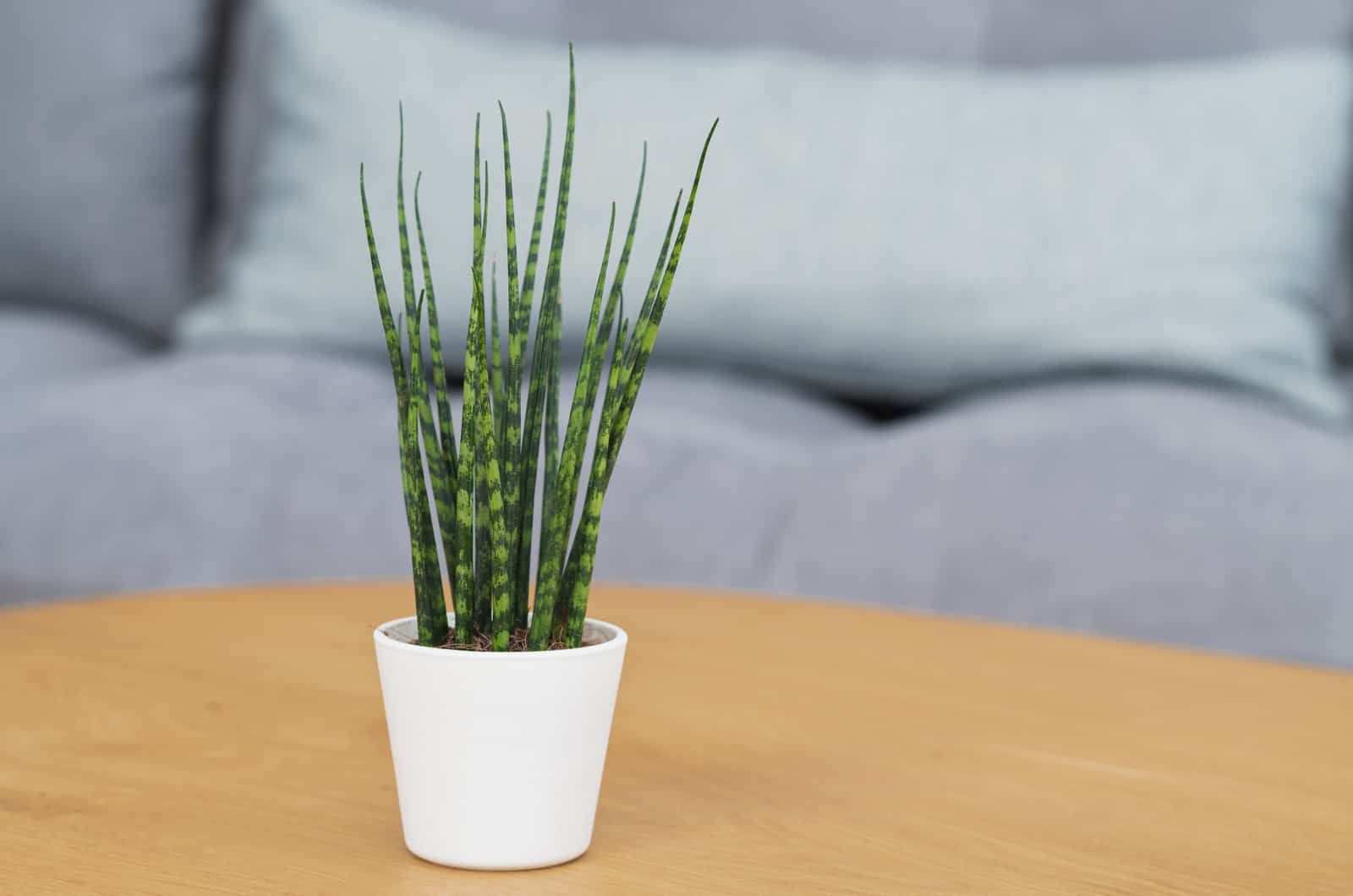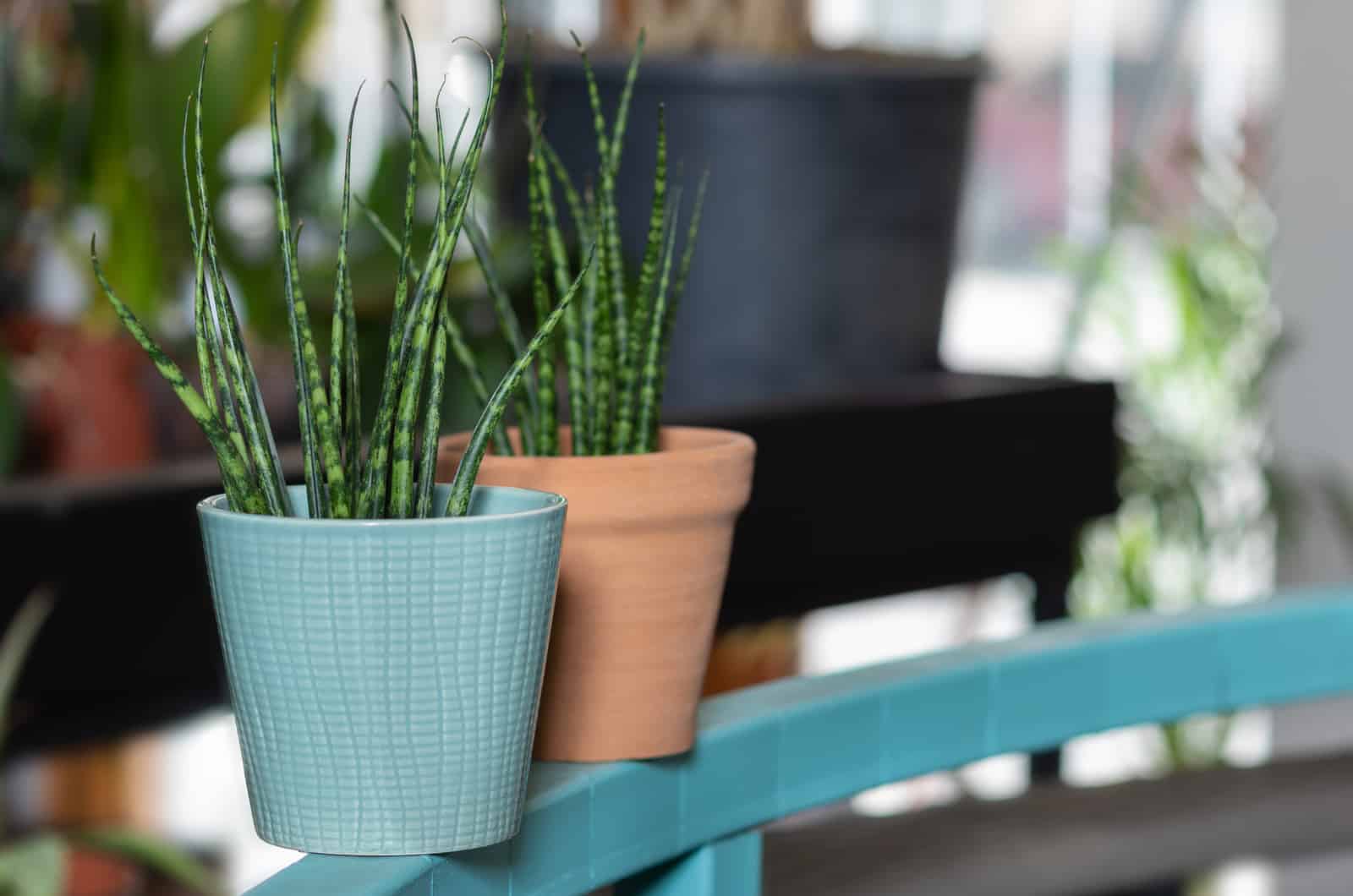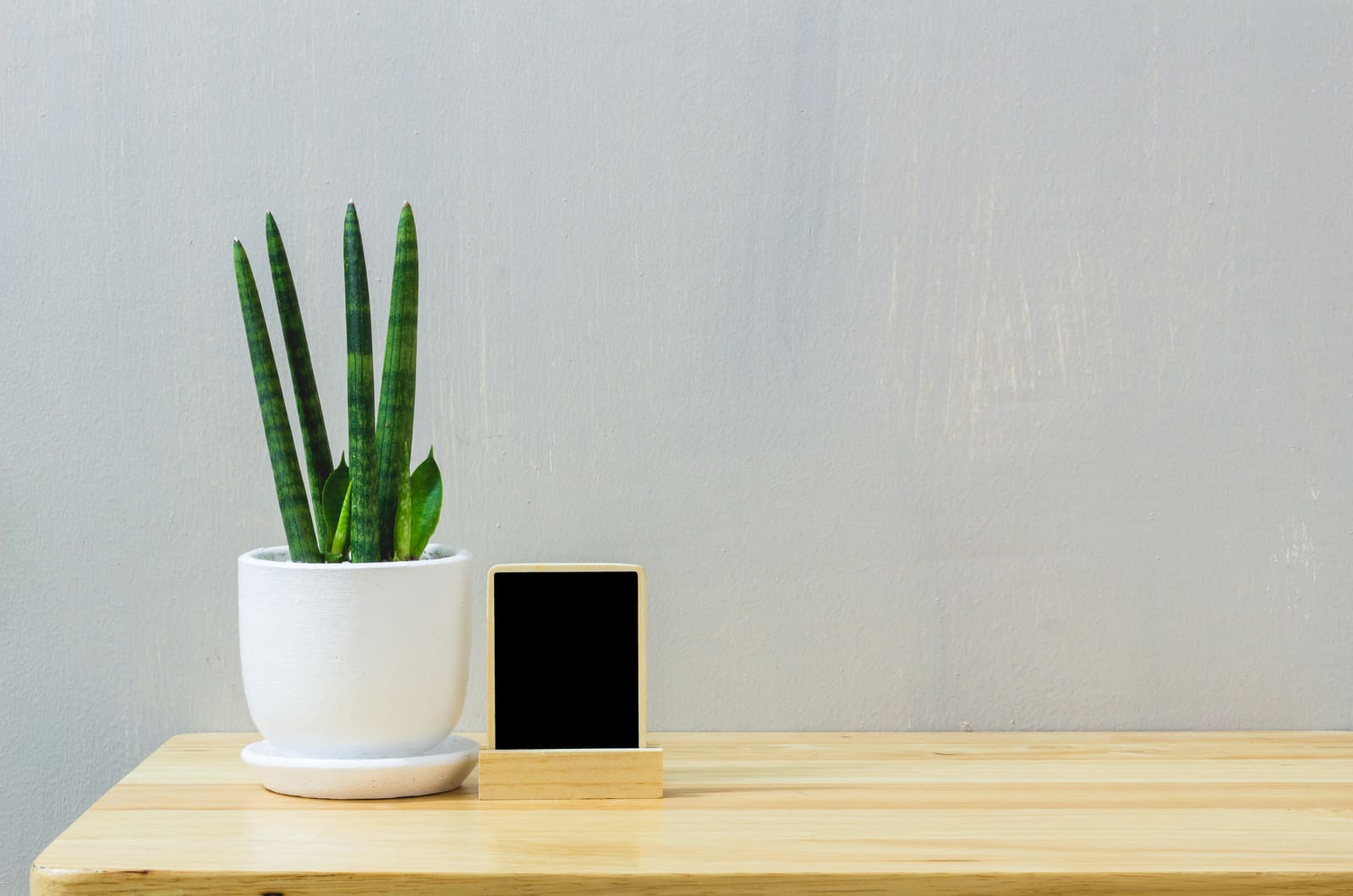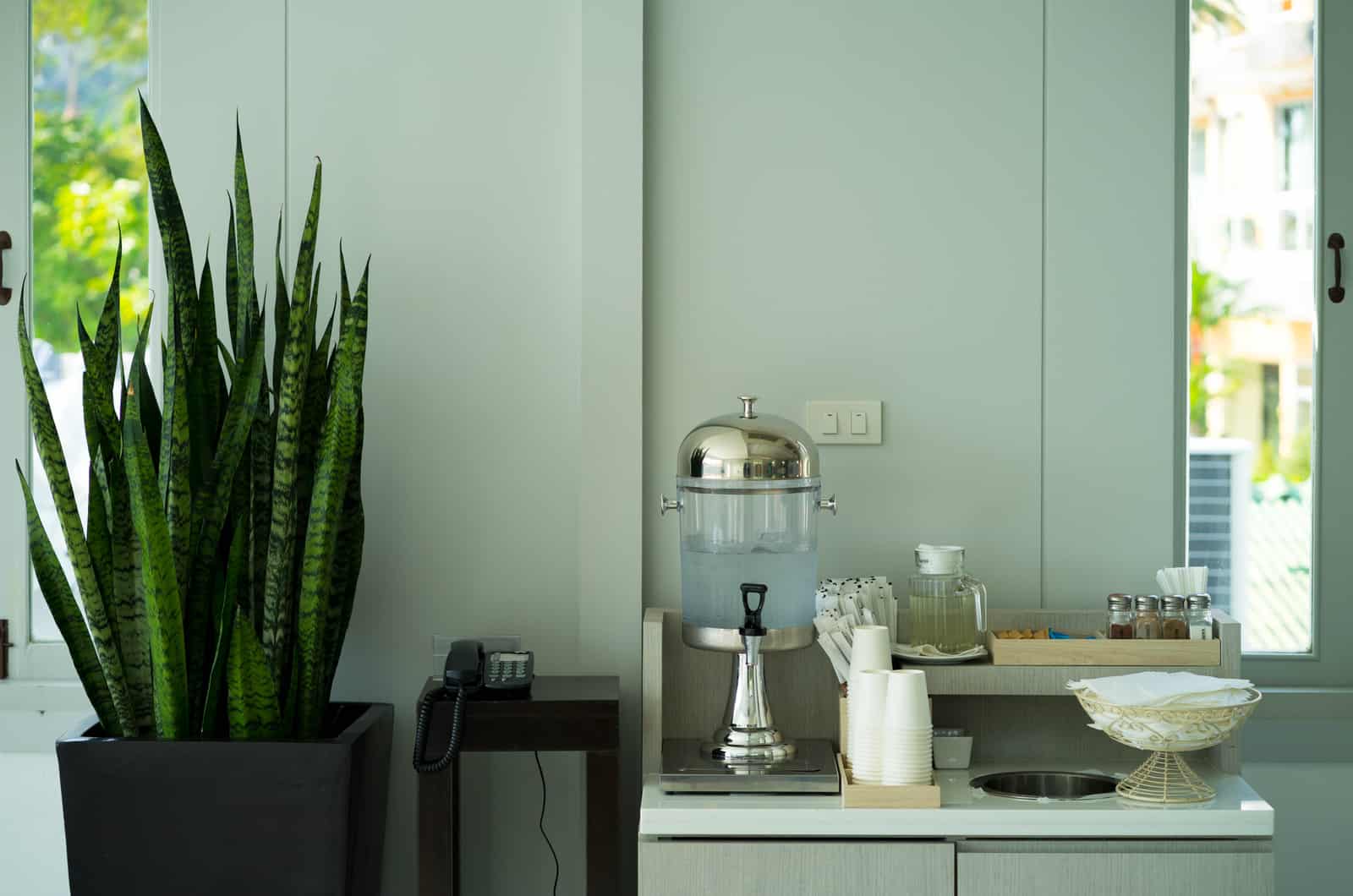Snake plant care is quite straightforward; all you have to do is ensure you place it in a moderately-lit spot, water it whenever the topsoil is dry, and plant it in a well-draining substrate.
However, even with the best intentions, sometimes things just go wrong and you end up with skinny snake plant leaves ! But don’t worry, we’ve got you covered with this article that brings you the causes and solutions to your skinny plant problems!
We’ll also go through some other common issues you may experience with this houseplant and how to deal with them.
Before we get into all that, let’s examine the main characteristics of snake plants:
[table id=194 /]
Now, let’s help your snake plant regain its elegance and beauty!
What Causes A Skinny Snake Plant?
The snake plant, or mother-in-law’s tongue, thrives in indirect-light conditions , but when this condition isn’t met the leaves become narrow and droop because they cannot handle the weight.
However, improper lighting isn’t the only cause of thin leaves. Inadequate watering, poor soil conditions, and an unsuitable container are all likely culprits.
Once you know what causes skinny leaves, you can avoid those situations and keep your plant healthy and thriving!
Low-Light Conditions
This might be a bit surprising, but the snake plant doesn’t like low-light levels. It can tolerate some shade, but it thrives in bright light .
In most cases, if you place your mother-in-law’s tongue in a dimly lit area its growth will slow down, but it will still maintain its beautiful looks. However, sometimes we misunderstand the difference between dimly lit and dark.
Snake plants cannot grow in dark areas so they keep searching for light, which is why they may grow leggy and skinny. They sense where the light is and stretch towards its source, so it’s pretty common to see it slanting to one side.
However, keeping this indoor plant in an area that isn’t too dark with at least a little bit of sunlight won’t lead to the narrowing of the leaves. Low light will stunt your plant’s growth , but you can learn how fast snake plants grow and how to speed it up right here.
Too Much Sunlight
On the other end of the spectrum is exposing your snake plant to too much sunlight. This plant thrives in moderately-lit areas, and exposing it to full sun and direct sunlight can thin and dry its leaves.
The water evaporates too fast and leaves the sansevieria leaves dry and thin. Direct sunlight can cause many other issues and lead to pale, yellow, or brown unsightly foliage.
Remember, a snake plant needs five or more hours of indirect sunlight each day to be at its best.
Overwatering And Underwatering
Overwatering leads not only to skinny plant leaves, but also to many other issues such as drooping and yellow leaves, browning of the tips, and even root rot .
It might be contradictory that too much water leads to skinny leaves. Still, if the plant absorbs plenty of water it will transpire more and lose it through its leaves, which makes them appear more skinny , especially if the humidity levels are low.
Overwatering can also lead to mushy and soft foliage, which is usually a sign that your plant is infected with root rot .
Another thing that can make this perennial skinny is not watering it enough. This makes more sense because succulent leaves cannot bulge and have that fleshy texture when there isn’t enough water.
If you don’t water your snake plant properly, its leaves will shrink and have a skinny look.
Small Pot
We all know that plants need properly sized containers to grow. Even though snake plants don’t grow at the speed of light, they can still outgrow their pot if you don’t practice repotting .
The roots become pot-bound because they don’t have enough room to grow, and your snake plant’s growth will slow down and become slender and thin . A small pot also indicates that there isn’t enough potting mix for your plant to draw nutrients from, and this leads to another cause we’ll discuss below.
Nutrient Deficiency
Nutrient deficiency is a serious issue and can really harm your plant. It is also one of the reasons your snake plant isn’t growing , and as this is a slow grower , you should do everything you can to help increase its height.
Skinny leaves and slow growth may not be that big of a deal to you, but a lack of nutrients can actually kill your plant because it will lose the ability to build cells and produce energy.
Your plant may use all the phosphorus, magnesium, iron, and calcium important for chlorophyll production, and without it, the plant cannot engage in the process of photosynthesis and produce energy and food to sustain itself.
Nutrient deficiency can manifest in other ways, not just skinny plant leaves. For instance, nitrogen deficiency frequently leads to the yellowing of the leaves, whereas magnesium deficiency affects the plant’s height.
Skinny Variety
But what if none of the causes above are responsible for your plant’s leaves losing weight? It might just be that you own a skinny sansevieria variety.
There are many different types of snake plants , and you might have a Sansevieria cylindrica ( Dracaena angolensis), also known as the African spear.
This plant has slender, pointed, dark green and gray leaves that grow quite slowly. However, just like any other succulent , it forms rosettes that grow from underground rhizomes .
What To Do About A Skinny Snake Plant?
Now that you know the leading causes of skinny snake plant leaves , it’s time to see what we can do about it.
Unfortunately, there isn’t a cure that can magically transform the thin leaves into fleshy ones. Still, there are some things you can do to stop things from deteriorating even further.
In this section, we’ll examine some ways you can make your plant more healthy, but you should know that the best cure is prevention. It’s a great idea to study the causes and try to avoid them.
We know things happen, but we’ve got you covered!
Place It In A Sunny Spot
One of the best ways you can ensure your plant is getting enough light is by placing it near a window. But remember, snake plants cannot handle too much direct sunlight so it’s best to keep them somewhere they won’t get burned.
We prefer east-facing windows as the morning sun isn’t that harsh and won’t hurt the plant. However, if you live in a south or west-facing flat it isn’t the end of the world. You can still keep your snake plant near windows, just ensure that they are a few feet away so the afternoon sun doesn’t scorch them.
We must also add that you shouldn’t suddenly expose your plant to direct sunlight, especially if it has spent most of its life in low-light conditions. Introduce it to the light gradually by placing it near a window for a few hours at a time.
After that, you should increase the amount of time and exposure to the light every day until your plant gets used to the sun and it can sit on an east-facing windowsill without getting sunburned.
However, keep in mind the snake plant’s temperature tolerance when exposing it to light as really high temperatures can lead to many issues, such as splitting and wrinkly leaves, browning of the tips, and blackening of the foliage.
Get Grow Lights
If you live in a north-facing home, there’s no reason to worry because there are things you can do to keep your snake plant happy even in the darkest of spaces.
Getting some grow lights from Amazon or any other place is an excellent way of providing your plant with its basic light requirements. It could even be considered a better choice than actual sunlight because you have more control over it and don’t have to worry about burning your plant’s tips and leaves.
There are many types of grow lights available on the market, and you’ll have to find the one that fits your plant’s needs best. We’d suggest getting ones that don’t generate too much heat, but any light works really. If it dissipates heat, simply place it further away from your plant.
Rotate Your Snake Plant
Another great way to avoid legginess and skinniness in plants is by rotating them every once in a while. We already mentioned that snake plants (and plants in general) grow towards the light, so if you don’t rotate your plant it will eventually lean to the side, which can really mess up with the vibe.
Your plant should make a full rotation once a month, but only gradually. Turn your plant 90° every week, and within a month it will be back where it started.
This method will provide equal sun exposure to the entire plant.
Remove The Narrow Leaves
Unfortunately, the skinny snake plant cannot heal on its own, but if you move it to a properly lit area you won’t have to wait long to see new growth .
However, if you really want your plant looking its very best you can remove the skinny parts. But if the conditions are advanced, don’t trim all the leaves at once or it could set your plant’s growth back several years. This is because it won’t have enough green surface to photosynthesize and produce the resources necessary for speedy progress.
Instead, you should cut the worst-looking leaves and then wait until you notice new leaves. Once it fully recovers, you’ll feel like you have a brand new snake plant !
Adjust The Watering Frequency
Watering requirements greatly depend on the climate and season, so you should adjust the frequency of watering accordingly.
The snake plant is a succulent , which means it stores water in its fleshy leaves and makes your job a lot easier. It doesn’t need that much water, especially in winter when it goes dormant. Therefore, you should water it every other week during its growing season and reduce that to once a month when winter approaches.
However, watering frequency also depends on light exposure, so you’ll have to water this plant more often if you keep it in a bright spot. Also, higher temperatures equal a higher transpiration rate, so you should give this belle more water as the temperatures rise.
Finally, the amount and frequency of watering depend on humidity as well, and if it’s higher you should water your plants less as they don’t transpire that much.
Thankfully, there is a way to tell exactly when you should water your green friend. Check the topsoil, and if the first two inches (5 cm) of the soil are dry you can go ahead and water this plant . If it isn’t, you should wait a couple of days and recheck the soil.
You can either use a moisture meter or your finger to measure the amount of moisture in the soil, both will work fine.
Repot Your Snake Plant
If the soil is too wet and you’re afraid it might kill your plant, you can simply repot it using fresh potting soil with good drainage. Also, the snake plant is on the list of plants that don’t need drainage holes , so you can pick any pot you find.
After repotting , water your plant thoroughly and then wait until the soil somewhat dries before irrigating it again.
Propagate Your Plant
The last option is propagating your plant. Select the most healthy leaf you can find, take some cuttings, and propagate them either in water or soil.
We’ll discuss both these techniques in the sections below. You can also propagate this plant through division, but that won’t solve your skinny problem; you’d just end up with two thin plants instead of one.
However, propagating snake plants through division is the fastest method as it already has an established root system, so you can give it a go once your plant heals.
Propagation In Water
The first step is to take a leaf cutting. You should find the healthiest leaf and take a cutting approximately 6 inches (15 cm) long. That was the hardest part!
Now you simply have to place the cutting in a glass container and add 3 inches (7.5 cm) of water. Place the vessel in a sunny spot and remember to refresh the water at least once a week!
This method does take some time, especially because the snake plant isn’t a fast grower , but within two months you should see transparent roots appearing. After they grow a bit, you can plant your green snake into a well-draining medium and watch it grow.
Propagation In Soil
Propagating leaf cuttings in the soil isn’t that different from water propagation, you simply have to place it in the soil instead of water, and that’s it!
You should also dip the leaf cutting in a rooting hormone before planting it half an inch (1.25 cm) in the soil. Water the substrate, keep it moist, and place the pot in a sun-lit spot.
The plant’s root system should start developing within two months, and if you notice that the pot has become too small for your new plant you can repot it in a bigger container.
Other Common Issues With The Snake Plant
We have discussed the skinny snake plant problem, but that isn’t the only issue that can affect this plant. We also mentioned some other problems that improper lighting and watering, nutrient deficiency , and small pots can cause.
However, there are other problems that we haven’t mentioned, so we will briefly examine some of them to help you save your indoor plant .
Deformed Foliage
Sometimes you may notice something wrong with your plant’s leaves, but you just can’t pinpoint what. In that case, the likely culprits are pests that nibble on your plant and drink its sap.
Another cause of deformed leaves may be fungal infections that develop in humid and hot weather. Therefore, you should monitor your plant and check up on it every now and then.
If you discover pests or diseases early, you can save your plant. Pests are easily removed, you just need to pick them off one by one if the infestation isn’t advanced, or use a pesticide for larger pest groups.
However, diseases are a bigger problem, but if caught early they don’t have to be. Simply remove the diseased parts and apply a fungicide to help battle the infection. If you leave your plant untreated for too long, you’ll have to get rid of it before the infection spreads to others.
Split Leaves
You may notice that your plant has cracks in the leaves that don’t seem to affect its health that much. There are many reasons for the splitting of snake plant’s leaves, such as nutrient deficiency, inadequate watering and lighting, pest infestations, etc.
Many different problems are caused by the same deficiencies, which is why you should get ahead of it all and prevent them from happening in the first place.
Curly Foliage
There are curly snake plant varieties, but flat ones don’t just decide to change species and become curly for no reason! If you notice curling and twisting of the leaves you should check the soil, because the main problem is usually underwatering.
However, pests and overfertilization can also lead to curly foliage . You should keep an eye on your plant and remove any insects as soon as you notice them. Also, snake plants aren’t heavy feeders, so you can add a slow-release fertilizer in spring and rest assured that your plant will have enough food before it enters dormancy.
Wrinkled Leaves
Wrinkly foliage is not attractive, so it’s no wonder we want to find what causes it and avoid those things. The most common cause of wrinkled leaves are high temperature and underwatering, so you should always strive to keep your plant between 65 and 85°F (18-29°C) and water it whenever the topsoil feels dry.
However, wrinkles can appear due to excessive light exposure and other stressors such as moving and repotting. Therefore, you should place it somewhere the direct light won’t get to it and give it some time to acclimate to its new environment.
FAQ
Snake plants are pretty popular, so it’s not surprising that there are so many questions about them. We picked the top three most frequently asked questions about these plants so we can make their basic needs as clear as possible.
Let’s see what we have in store!
What are the benefits of the snake plant?
The snake plant is a plant that has been declared by NASA to filter indoor air and remove harmful compounds such as toluene, formaldehyde, and benzene.
Another one of its great benefits is that it uses carbon dioxide at night and transforms it into oxygen.
However, this plant has its dark side, and some of the disadvantages of the snake plant make you wonder whether it is really worth it. It is toxic, grows rather slowly, and is susceptible to overwatering and all the issues that come with it.
But, it is also relatively easy to care for and has the ability to make the air cleaner, so it’s not all bad. You simply have to weigh its pros and cons and decide whether it is the right plant for you.
How do you prune the snake plant?
Pruning snake plants is quite easy, whether you want to make them more compact or eliminate diseased and damaged leaves.
The first thing you need is a pair of sharp gardening shears because snake plant’s leaves are fleshy, and even if they are skinny they can still be tough. Always sterilize the shears before using them because you don’t want to transfer any fungi or bacteria onto healthy plants.
Now that you’ve got that covered, you can start pruning your snake plant . The general rule of pruning is to cut off the outer leaves first and then work your way inside. Of course, if the skinny parts are on the inside you don’t have to remove the healthy parts.
Also, this plant’s leaves cannot regenerate and grow from cuts, so if you trim it somewhere in the middle it won’t grow its tip back. Therefore, you should always remove the leaves as close to the soil as possible.
You can learn more about pruning snake plants , how to propagate them, and what to do about droopy leaves in this video:
What are some popular snake plant varieties?
There are many different varieties of snake plants, including mother-in-law’s tongue ( Sansevieria trifasciata ), golden snake plant (Sansevieria laurentii superba), and variegated snake plant ( Sansevieria trifasciata ‘ Laurentii ’).
However, there are many more varieties out there, and you simply have to decide whether you want a plant with narrow or wide leaves, tall or short, straight or curly, etc.
Conclusion
We examined the common causes of a skinny snake plant so that you know what to avoid and what things to adjust.
However, sometimes things can get out of hand, or we simply forget to water our plant or move it to a sunnier spot. It’s not the end of the world if your plant grows thinner, you can still save it by changing your habits and giving it what it needs.
We also went over some other common issues as they are usually caused by the same things. That way, you can recognize what’s bugging your plant and save it while there’s still time.
Good luck, and don’t forget to move your snake plant to a brighter area!
Until next time!
Like this post? Share or pin it for later!






